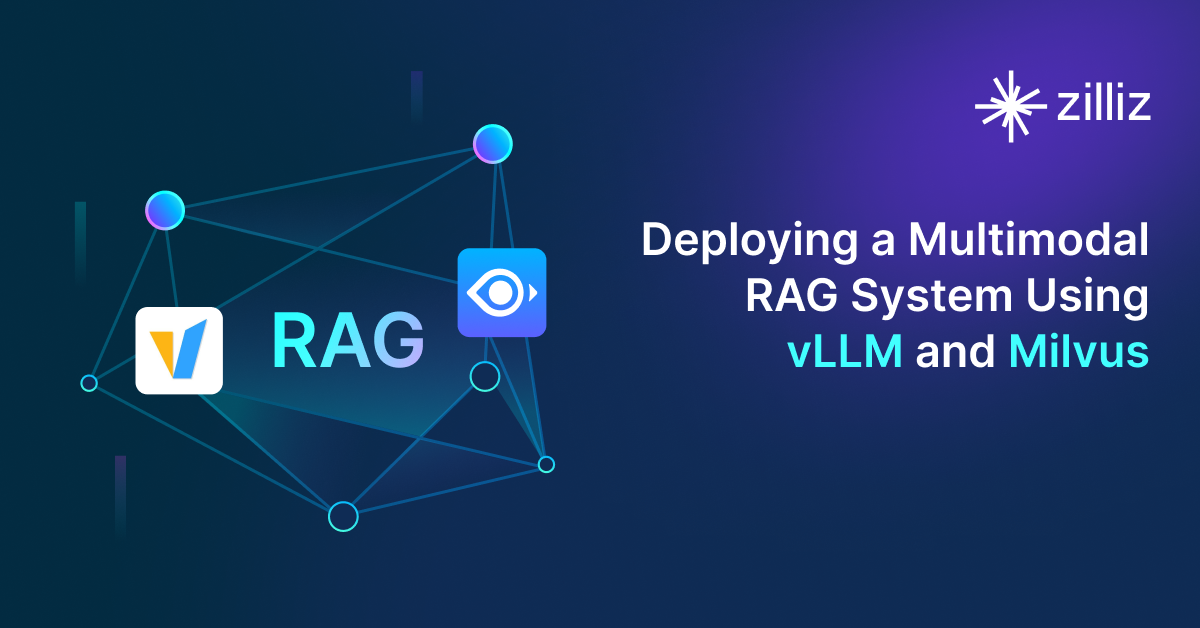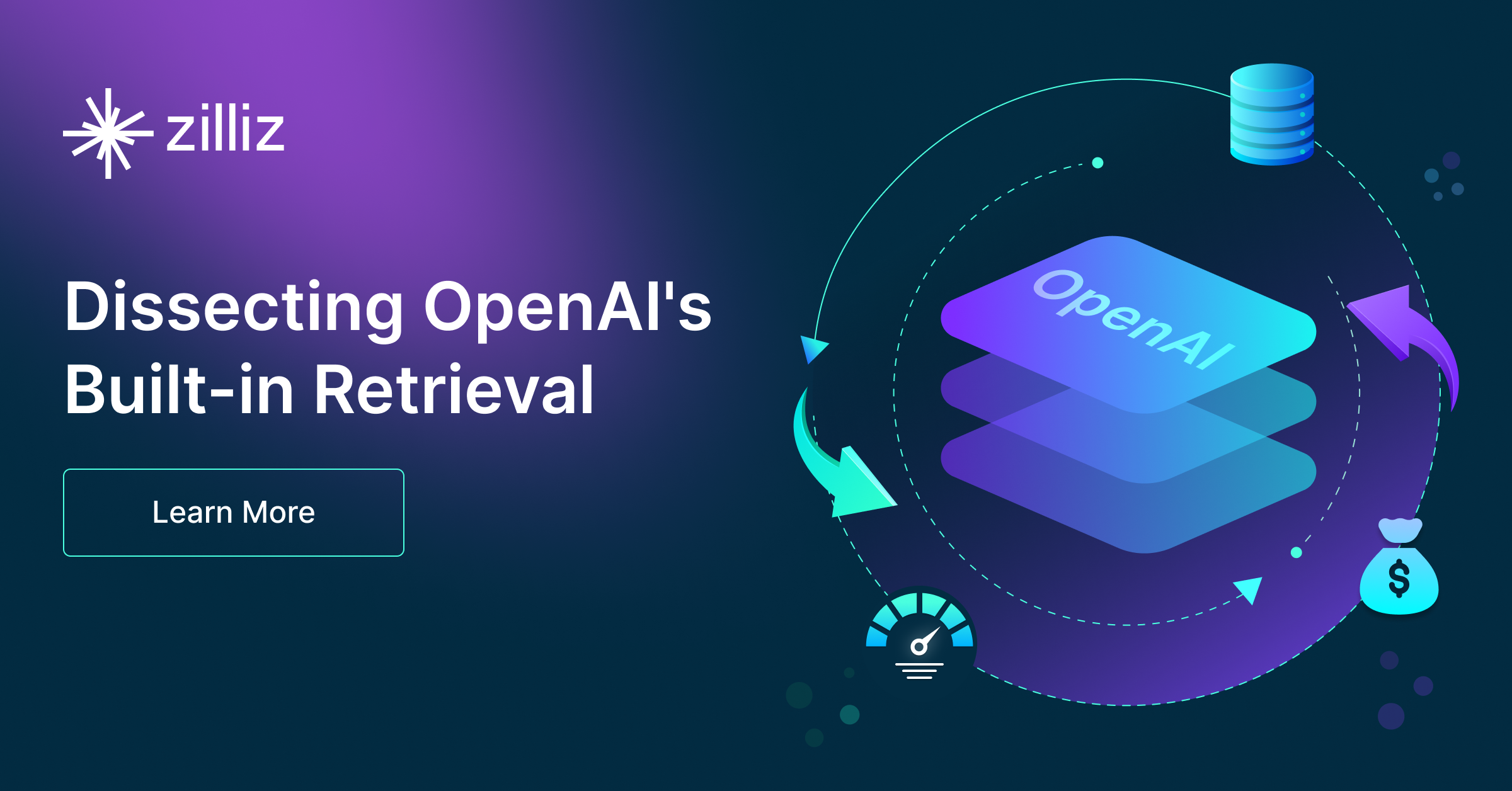Build RAG Chatbot with LangChain, OpenSearch, Google Vertex AI Gemini 1.5 Flash, and Ollama mxbai-embed-large
Introduction to RAG
Retrieval-Augmented Generation (RAG) is a game-changer for GenAI applications, especially in conversational AI. It combines the power of pre-trained large language models (LLMs) like OpenAI’s GPT with external knowledge sources stored in vector databases such as Milvus and Zilliz Cloud, allowing for more accurate, contextually relevant, and up-to-date response generation. A RAG pipeline usually consists of four basic components: a vector database, an embedding model, an LLM, and a framework.
Key Components We'll Use for This RAG Chatbot
This tutorial shows you how to build a simple RAG chatbot in Python using the following components:
- LangChain: An open-source framework that helps you orchestrate the interaction between LLMs, vector stores, embedding models, etc, making it easier to integrate a RAG pipeline.
- OpenSearch: An open-source search and analytics suite derived from Elasticsearch. It offers robust full-text search and real-time analytics, with vector search available as an add-on for similarity-based queries, extending its capabilities to handle high-dimensional data. Since it is just a vector search add-on rather than a purpose-built vector database, it lacks scalability and availability and many other advanced features required by enterprise-level applications. Therefore, if you prefer a much more scalable solution or hate to manage your own infrastructure, we recommend using Zilliz Cloud, which is a fully managed vector database service built on the open-source Milvus and offers a free tier supporting up to 1 million vectors.)
- Google Vertex AI Gemini 1.5 Flash: An advanced AI model designed for real-time applications, Gemini 1.5 Flash is optimized for speed and responsiveness in predictive analytics and NLP tasks. Its strengths lie in generating insights rapidly while ensuring accuracy, making it ideal for use cases in customer service automation and dynamic content generation.
- Ollama mxbai-embed-large: This advanced AI model specializes in generating high-quality embeddings for natural language processing tasks. Its strength lies in capturing nuanced meanings and relationships within text data, making it ideal for semantic search, recommendation systems, and content clustering applications.
By the end of this tutorial, you’ll have a functional chatbot capable of answering questions based on a custom knowledge base.
Note: Since we may use proprietary models in our tutorials, make sure you have the required API key beforehand.
Step 1: Install and Set Up LangChain
%pip install --quiet --upgrade langchain-text-splitters langchain-community langgraph
Step 2: Install and Set Up Google Vertex AI Gemini 1.5 Flash
pip install -qU "langchain[google-vertexai]"
# Ensure your VertexAI credentials are configured
from langchain.chat_models import init_chat_model
llm = init_chat_model("gemini-1.5-flash", model_provider="google_vertexai")
Step 3: Install and Set Up Ollama mxbai-embed-large
pip install -qU langchain-ollama
from langchain_ollama import OllamaEmbeddings
embeddings = OllamaEmbeddings(model="mxbai-embed-large")
Step 4: Install and Set Up OpenSearch
pip install --upgrade --quiet opensearch-py langchain-community
from langchain_community.vectorstores import OpenSearchVectorSearch
opensearch_vector_search = OpenSearchVectorSearch(
"http://localhost:9200",
"embeddings",
embedding_function
)
Step 5: Build a RAG Chatbot
Now that you’ve set up all components, let’s start to build a simple chatbot. We’ll use the Milvus introduction doc as a private knowledge base. You can replace it with your own dataset to customize your RAG chatbot.
import bs4
from langchain import hub
from langchain_community.document_loaders import WebBaseLoader
from langchain_core.documents import Document
from langchain_text_splitters import RecursiveCharacterTextSplitter
from langgraph.graph import START, StateGraph
from typing_extensions import List, TypedDict
# Load and chunk contents of the blog
loader = WebBaseLoader(
web_paths=("https://milvus.io/docs/overview.md",),
bs_kwargs=dict(
parse_only=bs4.SoupStrainer(
class_=("doc-style doc-post-content")
)
),
)
docs = loader.load()
text_splitter = RecursiveCharacterTextSplitter(chunk_size=1000, chunk_overlap=200)
all_splits = text_splitter.split_documents(docs)
# Index chunks
_ = vector_store.add_documents(documents=all_splits)
# Define prompt for question-answering
prompt = hub.pull("rlm/rag-prompt")
# Define state for application
class State(TypedDict):
question: str
context: List[Document]
answer: str
# Define application steps
def retrieve(state: State):
retrieved_docs = vector_store.similarity_search(state["question"])
return {"context": retrieved_docs}
def generate(state: State):
docs_content = "\n\n".join(doc.page_content for doc in state["context"])
messages = prompt.invoke({"question": state["question"], "context": docs_content})
response = llm.invoke(messages)
return {"answer": response.content}
# Compile application and test
graph_builder = StateGraph(State).add_sequence([retrieve, generate])
graph_builder.add_edge(START, "retrieve")
graph = graph_builder.compile()
Test the Chatbot
Yeah! You've built your own chatbot. Let's ask the chatbot a question.
response = graph.invoke({"question": "What data types does Milvus support?"})
print(response["answer"])
Example Output
Milvus supports various data types including sparse vectors, binary vectors, JSON, and arrays. Additionally, it handles common numerical and character types, making it versatile for different data modeling needs. This allows users to manage unstructured or multi-modal data efficiently.
Optimization Tips
As you build your RAG system, optimization is key to ensuring peak performance and efficiency. While setting up the components is an essential first step, fine-tuning each one will help you create a solution that works even better and scales seamlessly. In this section, we’ll share some practical tips for optimizing all these components, giving you the edge to build smarter, faster, and more responsive RAG applications.
LangChain optimization tips
To optimize LangChain, focus on minimizing redundant operations in your workflow by structuring your chains and agents efficiently. Use caching to avoid repeated computations, speeding up your system, and experiment with modular design to ensure that components like models or databases can be easily swapped out. This will provide both flexibility and efficiency, allowing you to quickly scale your system without unnecessary delays or complications.
OpenSearch optimization tips
To optimize OpenSearch in a Retrieval-Augmented Generation (RAG) setup, fine-tune indexing by enabling efficient mappings and reducing unnecessary stored fields. Use HNSW for vector search to speed up similarity queries while balancing recall and latency with appropriate ef_search and ef_construction values. Leverage shard and replica settings to distribute load effectively, and enable caching for frequent queries. Optimize text-based retrieval with BM25 tuning and custom analyzers for better relevance. Regularly monitor cluster health, index size, and query performance using OpenSearch Dashboards and adjust configurations accordingly.
Google Vertex AI Gemini 1.5 Flash optimization tips
Gemini 1.5 Flash is optimized for low-latency inference, making it ideal for real-time RAG applications. Improve efficiency by filtering out low-relevance documents before retrieval, ensuring optimal token usage. Use structured prompts with clear formatting to enhance response clarity. Keep temperature between 0.1 and 0.2 for accuracy, fine-tuning top-p as needed. Leverage Google’s AI infrastructure for dynamic scaling to handle fluctuating workloads. Implement caching for common queries to reduce redundant processing. In a multi-model deployment, use Gemini 1.5 Flash for fast responses while reserving Pro models for deeper reasoning.
Ollama mxbai-embed-large optimization tips
To optimize the Ollama mxbai-embed-large component in a Retrieval-Augmented Generation (RAG) setup, consider fine-tuning the embedding model on domain-specific data to enhance relevance in retrieval tasks. Utilize batching for input queries to improve throughput and efficiency, and implement caching mechanisms for frequently accessed embeddings to reduce latency. Monitor and analyze performance metrics to identify bottlenecks and iteratively adjust hyperparameters, such as learning rate and embedding size, while leveraging mixed-precision training to balance accuracy and resource utilization. Finally, regularly update your embedded database with fresh data to maintain the accuracy of retrieval results, ensuring your RAG system remains effective and responsive.
By implementing these tips across your components, you'll be able to enhance the performance and functionality of your RAG system, ensuring it’s optimized for both speed and accuracy. Keep testing, iterating, and refining your setup to stay ahead in the ever-evolving world of AI development.
RAG Cost Calculator: A Free Tool to Calculate Your Cost in Seconds
Estimating the cost of a Retrieval-Augmented Generation (RAG) pipeline involves analyzing expenses across vector storage, compute resources, and API usage. Key cost drivers include vector database queries, embedding generation, and LLM inference.
RAG Cost Calculator is a free tool that quickly estimates the cost of building a RAG pipeline, including chunking, embedding, vector storage/search, and LLM generation. It also helps you identify cost-saving opportunities and achieve up to 10x cost reduction on vector databases with the serverless option.
 Calculate your RAG cost
Calculate your RAG cost
What Have You Learned?
By diving into this tutorial, you’ve unlocked the power to build a fully functional RAG system from the ground up! You learned how LangChain acts as the glue holding everything together, orchestrating workflows between your data, models, and search tools. OpenSearch stepped in as your trusty vector database, storing and retrieving information with blazing speed and precision. Ollama’s mxbai-embed-large model transformed your raw text into rich, meaningful embeddings, capturing the essence of your data so OpenSearch could find exactly what you needed. Then, Google Vertex AI’s Gemini 1.5 Flash took center stage, generating human-like responses that feel natural and insightful by leveraging the context you retrieved. Together, these pieces formed a seamless pipeline—ingesting data, embedding it, searching intelligently, and synthesizing answers that feel almost magical. Along the way, you picked up pro tips like optimizing chunking strategies, balancing speed and accuracy with hybrid search, and even calculating costs with the free RAG cost calculator to keep your projects budget-friendly.
Now that you’ve seen how these tools harmonize, the real fun begins! You’re equipped to experiment, tweak, and scale your RAG applications for anything from customer support bots to research assistants. Remember, every optimization you apply—like fine-tuning embeddings or adjusting retrieval thresholds—can turn a good system into an exceptional one. The tutorial gave you the blueprint, but your creativity is the spark. So go ahead—build something that surprises you, solves real problems, or even reshapes how people interact with information. The world of AI is moving fast, and you’re now part of the wave. Let’s get coding, innovating, and pushing what’s possible with RAG. Your next breakthrough is just a few lines of code away! 🚀
Further Resources
🌟 In addition to this RAG tutorial, unleash your full potential with these incredible resources to level up your RAG skills.
- How to Build a Multimodal RAG | Documentation
- How to Enhance the Performance of Your RAG Pipeline
- Graph RAG with Milvus | Documentation
- How to Evaluate RAG Applications - Zilliz Learn
- Generative AI Resource Hub | Zilliz
We'd Love to Hear What You Think!
We’d love to hear your thoughts! 🌟 Leave your questions or comments below or join our vibrant Milvus Discord community to share your experiences, ask questions, or connect with thousands of AI enthusiasts. Your journey matters to us!
If you like this tutorial, show your support by giving our Milvus GitHub repo a star ⭐—it means the world to us and inspires us to keep creating! 💖
- Introduction to RAG
- Key Components We'll Use for This RAG Chatbot
- Step 1: Install and Set Up LangChain
- Step 2: Install and Set Up Google Vertex AI Gemini 1.5 Flash
- Step 3: Install and Set Up Ollama mxbai-embed-large
- Step 4: Install and Set Up OpenSearch
- Step 5: Build a RAG Chatbot
- Optimization Tips
- RAG Cost Calculator: A Free Tool to Calculate Your Cost in Seconds
- What Have You Learned?
- Further Resources
- We'd Love to Hear What You Think!
Content
Vector Database at Scale
Zilliz Cloud is a fully-managed vector database built for scale, perfect for your RAG apps.
Try Zilliz Cloud for Free


